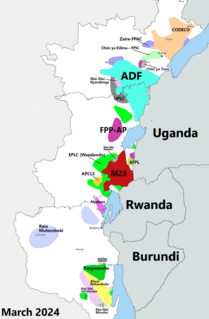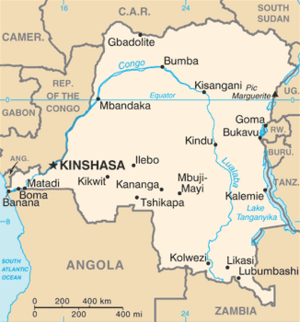
South Kivu, is one of 26 provinces of the Democratic Republic of the Congo. Its capital is Bukavu.

The United Nations Organization Stabilization Mission in the Democratic Republic of the Congo or MONUSCO, an acronym based on its French name Mission de l'Organisation des Nations Unies pour la stabilisation en République démocratique du Congo, is a United Nations peacekeeping force in the Democratic Republic of the Congo (DRC) which was established by the United Nations Security Council in resolutions 1279 (1999) and 1291 (2000) to monitor the peace process of the Second Congo War, though much of its focus subsequently turned to the Ituri conflict, the Kivu conflict and the Dongo conflict. The mission was known as the United Nations Mission in the Democratic Republic of Congo or MONUC, an acronym of its French name Mission de l'Organisation des Nations Unies en République démocratique du Congo, until 2010.

Football hooliganism, also known as soccer hooliganism, football riot or soccer riot, is a form of civil disobedience involving violence and other destructive behaviours perpetrated by spectators at association football events. Football hooliganism normally involves conflict between gangs, in English known as football firms, formed to intimidate and attack supporters of other teams. Other English-language terms commonly used in connection with hooligan firms include "army", "boys", "bods", "casuals", and "crew". Certain clubs have long-standing rivalries with other clubs and hooliganism associated with matches between them is likely to be more severe.

Goma is the capital of North Kivu province in the eastern Democratic Republic of the Congo. It is located on the northern shore of Lake Kivu, next to the Rwandan city of Gisenyi. The lake and the two cities are in the Albertine Rift, the western branch of the East African Rift system. Goma lies only 13–18 km (8.1–11.2 mi) south of the active Nyiragongo Volcano. The recent history of Goma has been dominated by the volcano and the Rwandan genocide of 1994, which in turn fuelled the First and Second Congo Wars. The aftermath of these events was still having effects on the city and its surroundings in 2010. The city was captured by rebels of the March 23 Movement during the M23 rebellion in late 2012, but it has since been retaken by government forces.

The Allied Democratic Forces is an Islamist rebel group in Uganda and the Democratic Republic of the Congo (DRC), considered a terrorist organisation by the Ugandan government. It was originally based in western Uganda but has expanded into the neighbouring DRC.

The Kivu conflict began in 2004 in the eastern Congo as an armed conflict between the military of the Democratic Republic of the Congo (FARDC) and the Hutu Power group Democratic Forces for the Liberation of Rwanda (FDLR) in the Democratic Republic of the Congo. It has broadly consisted of three phases, the third of which is an ongoing conflict. Prior to March 2009, the main combatant group against the FARDC was the National Congress for the Defence of the People (CNDP). Following the cessation of hostilities between these two forces, rebel Tutsi forces, formerly under the command of Laurent Nkunda, became the dominant opposition to the government forces.

The 2008 Nord-Kivu campaign was an armed conflict in the eastern Nord-Kivu province of the Democratic Republic of the Congo. The upsurge of violence in the Kivu conflict saw heavy battles between the Democratic Republic of Congo's army, supported by the United Nations, and Tutsi militia under General Laurent Nkunda.
Union Sportive Socozaki is a Congolese football club based in Butembo, North Kivu province. They were involved in a riot that broke out during a match against rival team Nyuki System in 2008 that led to the deaths of 13 people, mostly children.

The 2009 Houphouët-Boigny stampede occurred on 29 March 2009 in the Stade Félix Houphouët-Boigny in Abidjan, Ivory Coast before a 2010 FIFA World Cup qualification match between Malawi and Ivory Coast. Nineteen people were killed and 135 were injured. In an attempt to control a stampede police fired tear gas into the crowds, who had begun jostling with each other at least 40 minutes before kick off. The match was particularly popular among locals, with world stars such as Didier Drogba, Sol Bamba and Salomon Kalou due to play for Ivory Coast.
The word serhildan describes several Kurdish protests and uprisings since the 1990s that used the slogan "Êdî Bese" ("Enough") against Turkey. Local shops are often closed on the day of demonstrations as a form of protest.

The Allied Democratic Forces insurgency is an ongoing conflict waged by the Allied Democratic Forces in Uganda and the Democratic Republic of the Congo, against the governments of those two countries and the MONUSCO. The insurgency began in 1996, intensifying in 2013, resulting in hundreds of deaths. The ADF is known to currently control a number of hidden camps which are home to about 2,000 people; in these camps, the ADF operates as a proto-state with "an internal security service, a prison, health clinics, and an orphanage" as well as schools for boys and girls.
The 2014 Stade Tata Raphaël disaster refers to a stampede that occurred in Kinshasa, Democratic Republic of the Congo, at the Stade Tata Raphaël on 11 May 2014.
The following lists events that happened during 2012 in the Democratic Republic of the Congo.
The Antananarivo stampede occurred on June 26, 2019 in Antananarivo, Madagascar, before a Rossy concert at the Mahamasina Municipal Stadium, celebrating the country's 59th Independence Day. The show was about to start; people believed that they could enter the stadium and began to push, but the police left the doors closed. At least 16 people died and 101 others were injured.
Events in the year 2021 in the Republic of the Congo.

Crowd collapses and crushes are catastrophic incidents that can occur when a body of people becomes dangerously overcrowded. When a body of people reaches or exceeds the density of four to five people per square metre, the pressure on each individual can cause the crowd to collapse in on itself, or become so densely packed that individuals are crushed and asphyxiated. At this density, too, a crowd can start to act like a fluid, sweeping individuals around without their volition. Such incidents are invariably the product of failures of organization, and most major crowd disasters can be prevented by simple crowd management strategies. Such incidents can occur at large gatherings such as sporting, commercial, social, or religious events, though the critical factor is crowd density rather than crowd size. It is estimated that some 66,000 people were injured in crowd collapse and crush incidents between 1992 and 2002, though crowd scientists believe this to be a gross underestimate.

In late March 2022, the March 23 Movement (M23) launched an offensive in North Kivu, clashing with the Armed Forces of the Democratic Republic of the Congo (FARDC) and MONUSCO. The fighting displaced tens of thousands of civilians and caused renewed tensions between the Democratic Republic of the Congo and Rwanda, as the latter was accused of supporting the rebel offensive.
In 2022, heavy tensions broke out between the Democratic Republic of the Congo and Rwanda, which have led to several alleged attacks by Congolese and Rwandan forces on each others territory.











